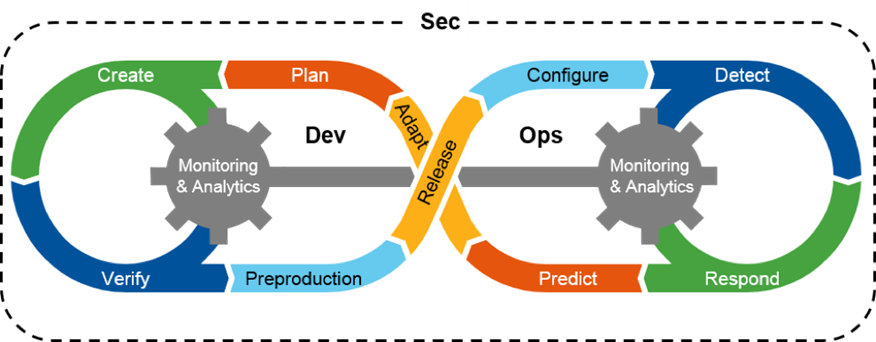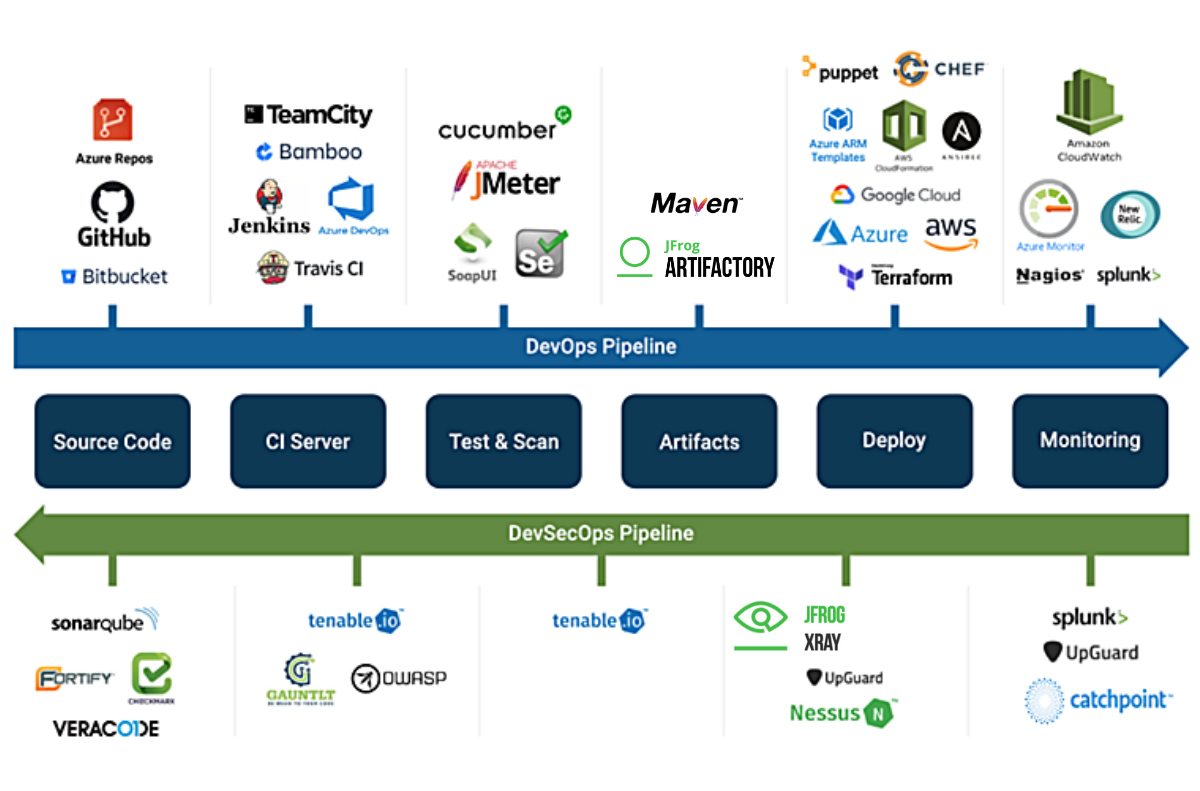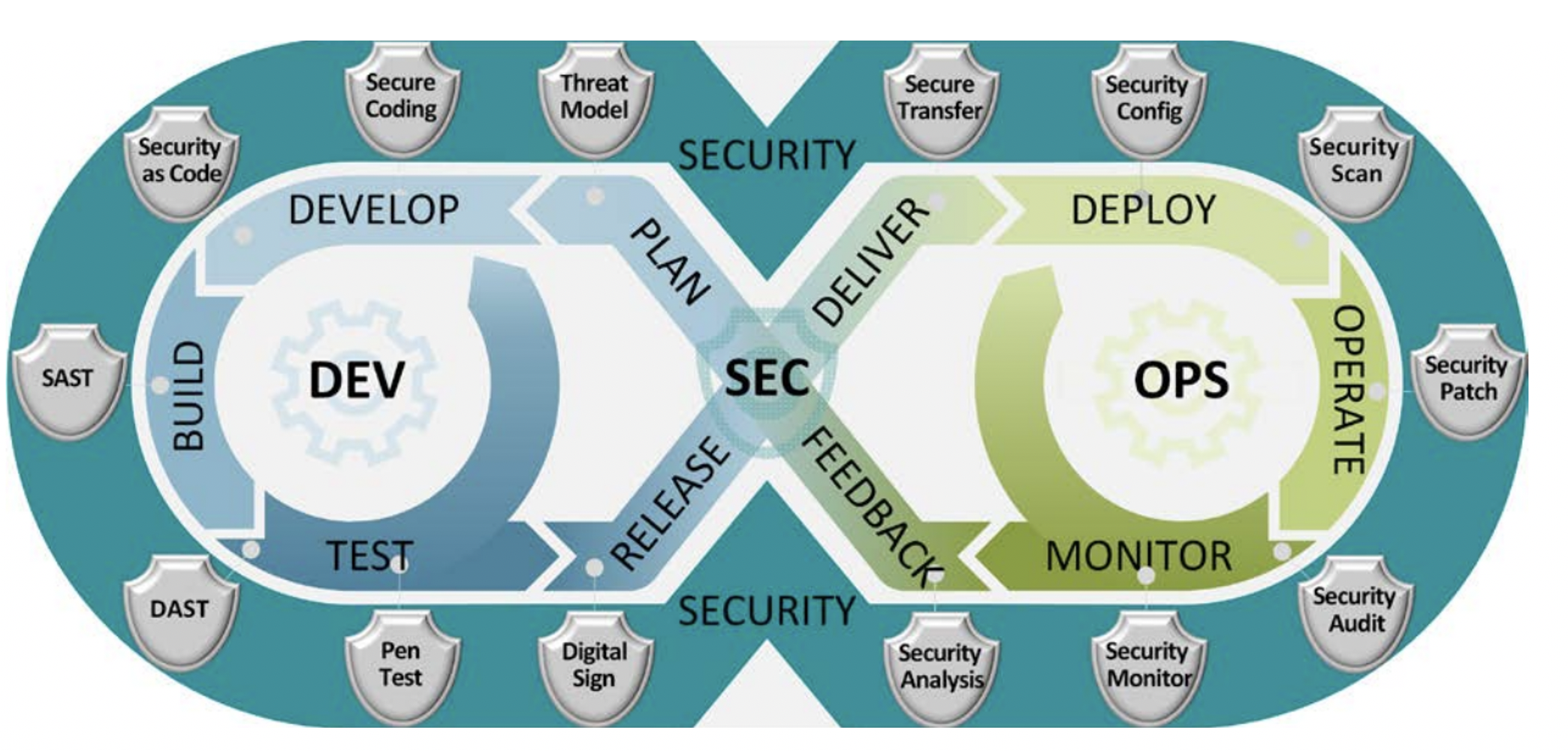
DevSecOps 101
DevSecOps is a software development methodology that integrates security into the entire software development lifecycle (SDLC). DevSecOps aims to shift security from being a separate stage of the SDLC to being a continuous process that is integrated into every stage of the development process, from planning and design to deployment and operations.
The goal of DevSecOps is to improve the security of software applications by making security a priority throughout the development process, rather than as an afterthought. This is achieved by incorporating security into the development process and integrating security tools and practices into the software development pipeline.
DevSecOps involves a collaboration between development, security, and operations teams, with a focus on automation, collaboration, and continuous integration and delivery (CI/CD). This approach enables organizations to identify and remediate security vulnerabilities and other issues early in the development process, reducing the risk of security breaches and improving the overall security of the software application.
DevSecOps also involves the use of security tools and technologies, such as static and dynamic code analysis, penetration testing, and runtime application self-protection (RASP), to improve the security of software applications. By adopting DevSecOps, organizations can improve the speed, quality, and security of their software development, and reduce the risk of security breaches and other security incidents.
In DevSecOps, what are best practices?
DevSecOps is the practice of integrating security into the software development process, to ensure the delivery of secure software. To achieve this, the following elements are usually required:
- Collaboration: Teams need to work together and share responsibilities across development, security and operations.
- Automation: To integrate security into the software development process, automated tools and processes are necessary to manage security tests, patches and updates.
- Integration of security tools: Security tools such as static code analysis, dynamic analysis, and vulnerability scanners need to be integrated into the development pipeline.
- Security culture: A security culture should be promoted across the organization, where security is integrated into all aspects of the software development process.
- Secure infrastructure: A secure infrastructure is required to ensure that applications and systems are protected from threats and vulnerabilities.
- Continuous monitoring: To ensure the security of software, it is necessary to continuously monitor for threats and vulnerabilities, and take action to remediate them.

What security tools and methods we use for DevSecOps
The security tools required for DevSecOps vary based on the specific needs of the organization and its software development process. However, some common security tools used in DevSecOps include:
- Static Code Analysis Tools: These tools scan the source code for potential security vulnerabilities, such as buffer overflows, SQL injections, and cross-site scripting (XSS) attacks.
- Dynamic Analysis Tools: These tools analyze the behavior of an application while it is running, to identify security vulnerabilities such as input validation issues and authentication weaknesses.
- Vulnerability Scanners: These tools scan applications, networks, and systems for known vulnerabilities and security threats, such as unpatched software, missing security updates, and misconfigurations.
- Container Security Tools: These tools help secure the deployment and operation of containers, including image scanning, runtime protection, and security monitoring.
- Cloud Security Tools: These tools provide security for cloud-based infrastructure, including identity and access management (IAM), encryption, and network security.
- Threat Intelligence Tools: These tools provide real-time threat intelligence and security alerts, allowing organizations to proactively respond to security incidents.
These are just a few examples of the security tools used in DevSecOps. It is important to note that different organizations may require different security tools based on their specific needs and requirements.
From experience with Federal Compliance, DevSecOps is a huge part of the compliance
Network security is a critical component of DevSecOps, as it helps to protect applications, systems, and data from potential threats and vulnerabilities. Some of the network security measures required for DevSecOps include:
- Firewall: A firewall helps to protect the network from unauthorized access by filtering incoming and outgoing network traffic based on predefined security rules.
- Intrusion Detection/Prevention System (IDS/IPS): These systems monitor network traffic for signs of malicious activity, such as malware infections or unauthorized access attempts, and take action to prevent them.
- Virtual Private Network (VPN): VPNs provide a secure, encrypted connection for remote users accessing the network, protecting sensitive data from eavesdropping and tampering.
- Encryption: Encryption helps to protect sensitive data from unauthorized access, both in transit (when data is being transmitted over the network) and at rest (when data is stored on disk).
- Network Segmentation: Network segmentation helps to reduce the attack surface by creating separate security domains within the network, making it more difficult for attackers to gain access to critical systems and data.
- Access Control: Access control measures, such as authentication and authorization, help to ensure that only authorized users are able to access the network and its resources.
These are just a few examples of the network security measures required for DevSecOps. It is important to implement a comprehensive and multi-layered security strategy that covers the entire network and its components, in order to provide adequate protection against potential threats and vulnerabilities.
Understanding GIT and best practices of utilizing a repository
Git is a distributed version control system, used for tracking changes in source code and coordinating work among multiple developers. A Git repository is a central location where the source code, along with its complete history and metadata, is stored and managed.
In a Git repository, developers can work on the same codebase simultaneously, and Git tracks and manages any changes made to the code. When a developer makes changes to the code, they can commit those changes to the repository, which records a new version of the code and its associated metadata, such as the author, date, and a commit message.
Git also allows developers to branch and merge code, which allows for parallel development and integration of multiple changes into a single codebase. This makes it easy to work on new features or bug fixes while preserving the main codebase and its history.
Overall, a Git repository is an essential tool for DevSecOps, as it helps to manage and track changes in the source code, collaborate with other developers, and maintain a secure and stable codebase.
What software vendors out there that provides GIT repository services?
There are several software vendors that provide Git repository services, including:
- GitHub: A web-based hosting service for version control repositories, with features such as bug tracking, project management, and team collaboration.
- GitLab: An open-source platform for Git repository management, with features such as continuous integration and delivery (CI/CD), issue tracking, and security scanning.
- Bitbucket: A web-based hosting service for version control repositories, with features such as issue tracking, pull requests, and integration with other tools.
- AWS CodeCommit: A fully managed source control service provided by Amazon Web Services (AWS), with features such as encryption of data in transit and at rest, and integration with other AWS services.
- Microsoft Azure DevOps: A set of development tools, services, and features provided by Microsoft Azure, including version control repositories, continuous integration and delivery, and project management.
These are just a few examples of the Git repository services provided by different software vendors. It is important to choose a Git repository service that meets the specific needs and requirements of the organization, taking into account factors such as security, scalability, and integration with other tools and systems.

Adapt a Shift Left Security
Shift Left Security is a security approach that focuses on integrating security earlier in the software development process. The idea behind Shift Left Security is to find and fix security vulnerabilities as early as possible in the development cycle, rather than waiting until later stages when they are more difficult and costly to address.
In traditional software development, security is often considered a separate phase, performed after the development and testing stages. With Shift Left Security, security is integrated into every stage of the development process, from design and planning to code development, testing, and deployment. This allows developers to identify and remediate security vulnerabilities early in the development cycle, when they are easier and less expensive to fix.
Shift Left Security also emphasizes collaboration between developers and security teams, with security experts providing guidance and feedback throughout the development process. By working together, the development and security teams can ensure that security is integrated into the software from the beginning, resulting in a more secure and reliable final product.
Overall, Shift Left Security is an important approach for organizations that are looking to improve the security of their software, reduce costs and risks, and deliver high-quality, secure software faster and more efficiently.
Why it’s important to do static code analysis
Static Code Analysis is a method of evaluating software source code for security vulnerabilities, coding errors, and other potential issues, without executing the code. The analysis is performed by software tools, known as Static Code Analyzers, that examine the source code and identify potential issues by using a set of rules and algorithms.
Static Code Analysis is performed early in the development cycle, before the code is compiled and executed, making it an effective way to identify and remediate security vulnerabilities, coding errors, and other issues early in the development process. By performing the analysis at this stage, organizations can reduce the cost and effort of fixing issues, as well as improve the quality and security of their software.
Static Code Analysis tools typically perform a wide range of checks, including checking for coding best practices, detecting known vulnerabilities and coding patterns that can lead to security issues, and enforcing coding standards and style guidelines. Some of the benefits of using Static Code Analysis include improved software quality, reduced costs associated with fixing security vulnerabilities and coding errors, and better alignment with coding and security standards.
Overall, Static Code Analysis is an important component of DevSecOps, as it helps organizations to find and fix security vulnerabilities and other issues early in the development process, resulting in a more secure and reliable software product.
When is it required to do a dynamic code analysis?
Dynamic Code Analysis is a method of evaluating software applications for security vulnerabilities, coding errors, and other potential issues by executing the code in a controlled environment. Unlike Static Code Analysis, which examines the source code without executing it, Dynamic Code Analysis involves executing the code and monitoring its behavior at runtime.
Dynamic Code Analysis is typically performed after the software has been built and is ready for testing. The software is executed in a controlled environment, typically using a test bed or simulation environment, and the tool analyzes the behavior of the software as it runs. This allows the tool to identify security vulnerabilities, coding errors, and other issues that might not be visible in the source code.
Dynamic Code Analysis tools typically use techniques such as fuzz testing, penetration testing, and runtime application self-protection (RASP) to evaluate the security and behavior of the software. Some of the benefits of Dynamic Code Analysis include the ability to identify security vulnerabilities that might not be detectable through Static Code Analysis, and the ability to evaluate the security and behavior of the software in a realistic environment that mimics its deployment environment.
Overall, Dynamic Code Analysis is an important component of DevSecOps, as it helps organizations to identify and remediate security vulnerabilities, coding errors, and other issues that might not be visible through Static Code Analysis. This results in a more secure and reliable software product that is better able to withstand attacks and other security threats.
Understand penetration testing
Penetration testing, also known as pen testing, is a simulated cyber attack on a computer system, network, or web application to evaluate the security of the system. The goal of penetration testing is to identify security vulnerabilities that could be exploited by attackers, and to assess the effectiveness of the system’s security controls.
Penetration testing is typically performed by security experts who use a combination of manual testing techniques and automated tools to simulate a real-world attack on the system. The testing process may include activities such as network scanning, vulnerability analysis, and exploitation of vulnerabilities to gain unauthorized access to the system.
Once the testing is complete, the results of the penetration testing are analyzed to identify the security vulnerabilities that were found, and to assess the impact of those vulnerabilities on the system and its data. Based on this analysis, recommendations are made to the organization to improve the security of the system, such as applying patches, configuring security controls, and implementing security best practices.
Penetration testing is an important component of a comprehensive security program, as it helps organizations to identify and remediate security vulnerabilities in their systems, and to assess the effectiveness of their security controls. By performing regular penetration testing, organizations can reduce the risk of security breaches, improve the security of their systems, and enhance their ability to protect their valuable data and assets.
Are you eager to unlock the full potential of your Federal Compliance journey?
We can provide guidance, tips and tricks with RiskGuardian360. Subscribe to our newsletter.


Our team is highly committed.
Our team possesses a strong passion for federal compliance.
Our team possesses a strong passion for federal compliance.
Therefore, we have traversed the trial-and-error path in our Federal Compliance Journey and have constructed an application employing AI to aid in Federal Compliance.

